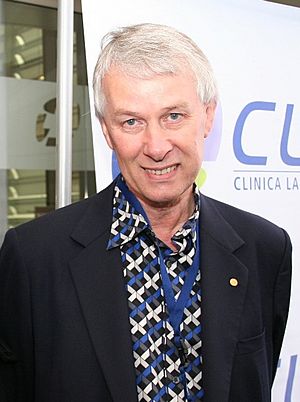Richard Roberts facts for kids
Quick facts for kids
Richard Roberts
|
|
|---|---|

Richard Roberts
|
|
| Born | 6 September 1943 |
| Nationality | British |
| Known for | introns |
| Awards | 1993 Nobel Prize in Physiology or Medicine |
| Scientific career | |
| Fields | molecular biologist |
Sir Richard John Roberts (born on September 6, 1943, in Derby, England) is a British biochemist and molecular biologist. He is famous for his important discoveries about how genes work.
In 1993, he won the Nobel Prize in Physiology or Medicine along with Phillip Sharp. They discovered that genes in living things like humans (called eukaryotes) are not simple, continuous strings. Instead, they contain special sections called introns. They also found that messenger RNA (mRNA) can be "spliced" to remove these introns. This process allows one gene to make different proteins.
Sir Richard Roberts has worked at top places like Harvard University and Cold Spring Harbor Laboratory. He was made a knight in 2008 for his contributions to science.
Contents
How Genes Work: Introns and Exons
For a long time, scientists thought that each gene on our DNA was a continuous piece of code. They believed this code directly told the body how to make one specific protein.
However, Richard Roberts and Phillip Sharp found something different. They were studying adenovirus, which causes the common cold. They discovered that the genes in this virus were actually split into segments. These segments were later put back together during a process involving RNA.
What are Exons and Introns?
In 1997, Roberts showed that in adenovirus, the parts of DNA that code for proteins are separated by non-coding sections. Think of it like a sentence where some words are important, and others are just filler.
- The coding sections are called exons. These are the "important words" that carry the instructions.
- The non-coding sections are called introns. These are the "filler words" that get removed.
This amazing discovery changed how we understand genes. It turned out that this split gene structure is found in all higher organisms, including humans. The idea that a gene could be made of several separate pieces was a big step forward in biology.

Gene Splicing and Genetic Engineering
The second part of Roberts' work was about gene-splitting and gene splicing. This means cutting out pieces from a gene's coding sequence and adding new pieces. This process can create a protein that works differently from the original.
Today, this knowledge is very important in genetic engineering. Scientists can use these techniques to change genes. This helps them understand diseases better and even develop new treatments.
Evolution and Gene Structure
The way genes are structured with introns and exons might help living things adapt faster. This structure could allow for more flexible responses to changes in the environment. This might even speed up evolution.
This structure may also be linked to some inherited genetic problems.
Professor Bertil Daneholt, from the Nobel Assembly, explained the importance of this discovery:
- "Earlier it was believed that genes evolve mainly through the accumulation of small discrete changes in the genetic material. But their mosaic gene structure also permits higher organisms to restructure genes in another, more efficient way. This is because during the course of evolution, gene segments - the individual pieces of the mosaic - are regrouped in the genetic material, which creates new mosaic patterns and hence new genes. This reshuffling process presumably explains the rapid evolution of higher organisms."
This means that genes can be "reshuffled" like puzzle pieces. This creates new combinations and new genes. This "reshuffling" might be why higher organisms have evolved so quickly.

